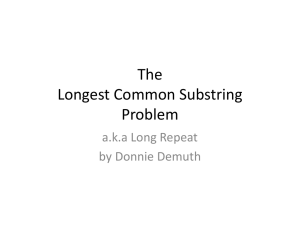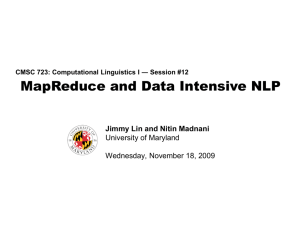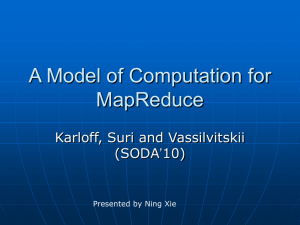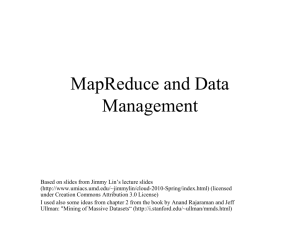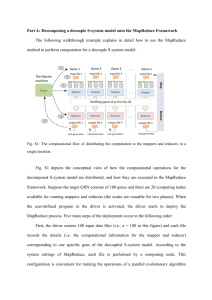Join algorithms using mapreduce
advertisement
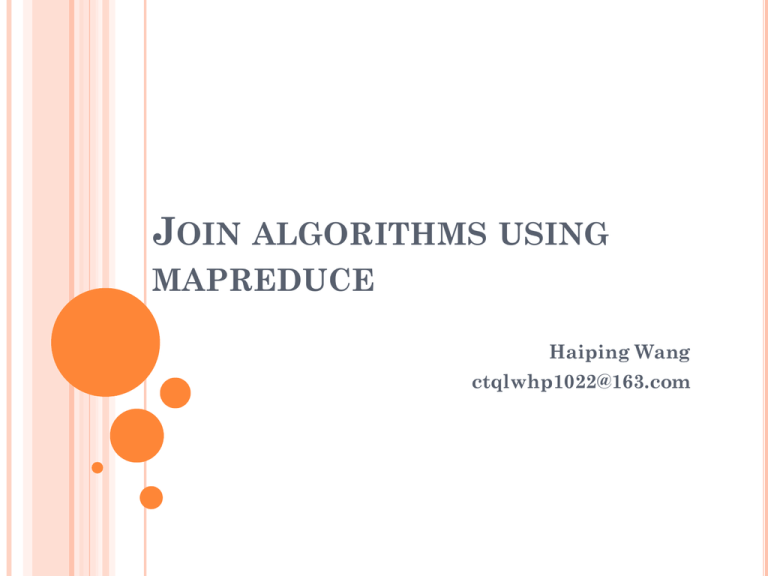
JOIN ALGORITHMS USING
MAPREDUCE
Haiping Wang
ctqlwhp1022@163.com
OUTLINE
MapReduce Framework
MapReduce implementation on Hadoop
Join algorithms using MapReduce
MAPREDUCE: SIMPLIFIED DATA
PROCESSING ON LARGE CLUSTERS. IN OSDI, 2004
MAPREDUCE WORDCOUNT DIAGRAM
file1
file2 file3
ah ah er
file4
ah
file5
file6
if or or uh
or
file7
ah if
map(String inputkey,
String inputvalue):
ah:1
ah:1 ah:1 er:1
if:1 or:1
or:1 uh:1 or:1
ah:1,1,1,1 er:1 if:1,1or:1,1,1 uh:1
reduce(String outputkey,
Iterator intermediate_alues):
4
(ah)
1
2
(er) (if)
3
1
(or) (uh)
ah:1 if:1
MAPREDUCE IMPLEMENTATION ON HADOOP
JobTracker
InputFormat
OutputFormat
Record
Writer
Record
Reader
Copy
Mapper
Partitioner
Sorter
Reducer
TaskTracker
MAPREDUCE IMPLEMENTATION ON
HADOOP
HADOOP MAPREDUCE FRAMEWORK
ARCHITECTURE
JOIN ALGORITHMS USING MAPREDUCE
Map-Reduce-Merge: Simplified Relational Data
Processing on Large Clusters sigmod07
Semi-join Computation on Distributed File
Systems Using Map-Reduce-Merge Model Sac10
Optimizing joins in a map-reduce environment
VLDB09,EDBT2010
A Comparison of Join Algorithms for Log
Processing in MapReduce sigmod10
MAP-REDUCE-MERGE: SIMPLIFIED RELATIONAL
DATA PROCESSING ON LARGE CLUSTERS SIGMOD07
MAP-REDUCE-MERGE IMPLEMENTATIONS OF
RELATIONAL JOIN ALGORITHMS
Sortmerger join
Hash join
Block
Nested
loop join
Map
range partitioner , ordered bucket s, each bucket a reducer
Reduce
Read the designed buckets from all mappers and merged them into a
sorted set
Merge
Read sorted buckets from two data sets and do sort-merge join
Map
Hash partitioner, hashed buckets, each bucket a reducer
Reduce
Read the designed buckets from all mappers , use a hash table to
group and aggregate these records(the same hash function as the
mapper ), does not need a sorter
Merge
In memory hash join
Map
The same as the hash join
Reduce
The same as the hash join
Merge
Nested loop join
EXAMPLE: HASH JOIN
•Read from two sets of reducer outputs that share the
same hashing buckets
•One is used as a build set and the other probe
merger
merger
merger
Read from every mapper for
one designated partition
reducer
reducer
reducer
reducer
reducer
reducer
Use a hash partitioner
mapper
mapper
mapper
mapper
mapper
mapper
split
split
split
split
split
split
split
split
ANALYSIS AND CONCLUSION
Connections
A(ma, ra ), B(mb , rb ), r mergers suppose ra=rb=r
Map->Reduce connections= ra*ma+rb*mb=r*(ma+mb)
Reduce->Merge in one-to-one case, connections=2r
matcher: compare tuples to see id they should be merged or
not
Conclusion
Use multiple map-reduce job
Partitioner may cause data skew problem
The number of ma, ra, mb, rb, r ra=rb? –> connections
SEMI-JOIN COMPUTATION STEPS AND
WORKFLOW
Equal join reduce communication costs disk I/O costs
Insensitive to data skew ?
A COMPARISON OF JOIN ALGORITHMS FOR
LOG PROCESSING IN MAPREDUCE SIGMOD10
Equi-join between a log table L and a reference table R
on a single column.
L ⊲⊳L.k=R.k R, with |L| ≫ |R|
L,R and the Join Result is stored in DFS.
Scans are used to access L and R.
Each map or reduce task can optionally implement two
additional functions: init() and close() .
These functions can be called before or after each map
or reduce task.
REPARTITION JOIN(HIVE)
input
map
Pairs: (key, targeted record)
1::1193::5::978300760
1::661::3::978302109
1::661::3::978301968
1::661::4::978300275
1 ::1193::5::97882429
1193, L:1::1193::5::978300760
661, L :1::661::3::978302109
661, L :1::661::3::978301968
661, L :1::661::4::978300275
1193, L :1 ::1193::5 ::97882429
shuffle
(661, …)
(661, …)
(661, …)
(1193, …)
(1193, …)
L: Ratings.dat
661::James and the
Glant…
914::My Fair Lady..
1193::One Flew Over
the…
2355::Bug’s Life, A…
3408::Erin Brockovich…
661, R:661::James and the Gla…
914, R: 914::My Fair Lady..
1193, R: 1193::One Flew Over …
2355, R: 2355::Bug’s Life, A…
3408, R: 3408::Erin Brockovi…
(661, …)
(2355, …)
(3048, …)
(914, …)
(1193, …)
R: movies.dat
reduce
Group by join key
(661,
[L :1::661::3::97…],
[R:661::James…],
[L:1::661::3::978…],
[L :1::661::4::97…])
(2355,
[R:2355::B’…])
(3408, [R:3408::Eri…])
output
{(661::James…) }
X
(1::661::3::97…),
(1::661::3::97…),
(1::661::4::97…)
(1,Ja..,3, …)
(1,Ja..,3, …)
(1,Ja..,4, …)
Buffers records into two sets
according to the table tag
+
Cross-product
Drawback: all records may have to be buffered
Out of memory
The key cardinality is small
The data is highly skewed
Phase /Function
Improvement
Map Function
Output key is changed to a composite of the join key and
the table tag.
Partitioning function
Hashcode is computed from just the join key part of the
composite key
Grouping function
Records are grouped on just the join key
THE COST MEASURE FOR MR ALGORITHMS
The communication cost of a process is the size of the
input to the process
This paper does not count the output size for a process
The output must be input to at least one other process
The final output is much smaller than its input
The total communication cost is the sum of the
communication costs of all processes that constitute
an algorithm
The elapsed communication cost is defined on the
acyclic graph of processes
Consider a path through this graph, and sum the
communication costs of the processes along that path
The maximum sum, over all paths is the elapsed
communication cost
2-WAY JOIN IN MAPREDUCE
Input
R
A
B
a0
b0
a1
b1
a2
b2
V
b0
(a0, R)
b0
(c0, S)
b0
(c1, S)
…
…
C
K
V
c0
b1
(a1, R)
b0
c1
b1
(c2, S)
b1
c2
…
…
…
…
B
b0
S
…
S(B,C)
Reduce input
K
…
R(A,B)
Map
Final output
Reduce
Table tuple
map
R
(a ,b )
b ->(a, R) Hash(b) ->(a, R)
S
(b , c )
b ->(c, S)
A
B
C
a0
b0
c0
a0
b0
c1
a1
b1
c2
…
…
…
Partition& sort
Hash(b) ->(c, S)
b->(a, c)
JOINING SEVERAL RELATIONS AT ONCE
R(A,B)
Input
S(B,C)
T(C,D)
Reduce input
R
S
T
Final output
Map
Reduce
JOINING SEVERAL RELATIONS AT ONCE
R(A,B)
S(B,C)
Let h be a hash
function with range 1,
2, …, m
S(b, c) -> (h(b), h(c))
R(a, b) -> (h(b), all)
T(c, d) -> (all, h(c))
T(C,D)
h(c) = 0
h(T.c) = 1
1
2
h(S.b) = 2
h(S.c) = 1
3
h(b) = 0
1
2
Each Reduce process
3
computes the join of
h(R.b) = 2
the tuples it receives
Reduce processes
(# of Reduce processes: 42 = 16)
m=4, k=16
PROBLEM SOLVING
Problem solving using the method of Lagrange
Multipliers
Take derivatives with respect to the three variables a,
b, c
Multiply the three equations
SPECIAL CASES
Star Joins
Chain Joins
A chain join is a join of the form
CONCLUSION
Just suitable for Equal join
Use one map-reduce
Does not consider the IO ( intermediate <K,V>
pairs IO ) and CPU time
Main contribution: use “Lagrangean multipliers”
method



